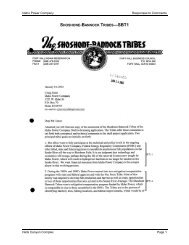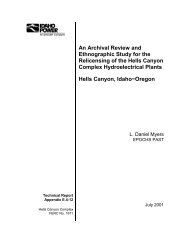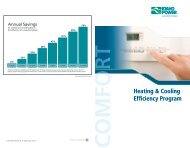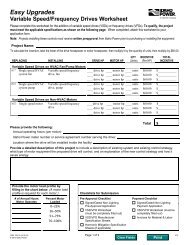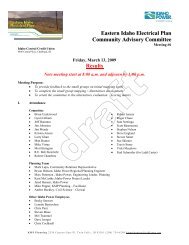n-1 Reliability Example - Idaho Power
n-1 Reliability Example - Idaho Power
n-1 Reliability Example - Idaho Power
You also want an ePaper? Increase the reach of your titles
YUMPU automatically turns print PDFs into web optimized ePapers that Google loves.
n-1 <strong>Reliability</strong> <strong>Example</strong><strong>Idaho</strong> <strong>Power</strong> must adhere to what’s known as an “n-1” criterion.For multiple transmission lines delivering power to the same point, if one of thelines goes out of service, the remaining lines must be able to carry both the loadthey were carrying before the event, plus the load carried by the line that is out ofservice.• This is true even if the line with the highest capacity is the one that goes outof service.• Only holds true for major transmission lines.Take for example three, extra-high voltage, 345,000-volt transmission lines operatingelectrically in parallel as shown in Figure 1. This means that they all originate in thesame location and deliver power to the same location. Each line might take a differentpath to get there, but all three begin and end in the same locations.Figure 1. Three Parallel Transmission LinesThe top line is 100 miles long and has a capacity of 725 MW. The middle line is also100 miles long and has a capacity of 1,053 MW. The bottom line is 200 miles long andhas a capacity of 780 MW. There is a substation located at the halfway point on thebottom line but it has no effect on the power flow.n-1 <strong>Example</strong> 1
Normal Operation, No Lines OutThe three lines in Figure 2 are carrying a total of 1,400 MW to a load located at BigTown Substation. Note that the generator is producing 1,406 MW of power while theload is only consuming 1,400 MW. The difference between the two is due to losses onthe transmission system…losses that must be provided for by the generator. The greenarrows shown on the drawings indicate the direction of power flow.Figure 2. Three Parallel Transmission Lines During Normal Operation.The blue circle on each transmission line is a visual indication of how much each line isloaded. The top circle indicates that the line is carrying about ¾ of the amount it iscapable of. If the circle turns orange, it indicates that the line is approaching itsmaximum capacity. A red circle indicates that the line has exceeded its capacity.All three lines are operating within their capacity and could operate like this indefinitely.Top line capacity = 725 MWTop line operating at 526 MWMiddle line capacity = 1053 MWMiddle line operating at 612 MWBottom line capacity = 780 MWBottom line operating at 263 MWn-1 <strong>Example</strong> 2
Bottom Line Out of ServiceNow lets see what happens if we take the bottom line out of service. The circuit breakerlocated on the right side of the line (red box in upper drawing) turns to a hollow greenwhen the circuit breaker is open, de-energizing the line.Figure 3. Three Parallel Transmission Lines, Bottom Line Out of Service.Notice that no power flows on the bottom line now. The middle line, which has thehighest capacity of all three, is now operating to about ¾ of its capability. The top lineindicates that it is operating at 89% of its capability, giving us a warning. However, theselines could operate like this indefinitely so no action is required. In this case, we havemet the n-1 criteria.Top line capacity = 725 MWTop line operating at 647 MWMiddle line capacity = 1053 MWMiddle line operating at 753 MWBottom line capacity = 780 MWBottom line operating at 0 MWNote that the generator on the right side of the drawing is producing more powercompared to the last case. This is because the power losses are higher with one of thelines out of service because there is more resistance to power flow.n-1 <strong>Example</strong> 3
Top Line Out of ServiceNow we will put the bottom line back in-service and take the top line out of service.Again, the circuit breaker on the right of the top line will go from solid red to hollowgreen indicating that the line is out of service.Figure 4. Three Parallel Transmission Lines, Top Line Out of Service.Notice that no power flows on the top line now. The bottom line indicates that it isoperating at about 2/3 of its capability while the middle line is warning us that it isoperating at 93% of its capability. These two lines could operate like this indefinitely soagain no action is required.Top line capacity = 725 MWTop line operating at 0 MWMiddle line capacity = 1053 MWMiddle line operating at 979 MWBottom line capacity = 780 MWBottom line operating at 421 to 422 MWAgain, notice that the generator is now producing more power due to the higher linelosses with one of the lines out of service.n-1 <strong>Example</strong> 4
Middle Line Out of ServiceThe top line is put back in service and the middle line is taken out of service. This isindicated in Figure 5 by the circuit breaker located on the right side of the middle linechanging from a solid red box to a hollow green box.Figure 5. Three Parallel Transmission Lines, Middle Line Out of Service.Figure 4 indicates that the bottom line is operating at about 2/3 of its capability and thiscan be maintained indefinitely. However, notice that the top line’s indicator shows that itis now operating at 129% of its capability. A transmission line cannot operate like thisfor very long because the line gets too hot and can be damaged to the point of breaking.So, in this case, our three transmission lines have failed the n-1 test. When the largesttransmission line was taken out of service, the other two could not safely carry the powerit was carrying plus the power they were carrying before the incident.Top line capacity = 725 MWTop line operating at 933 MWMiddle line capacity = 1053 MWMiddle line operating at 0 MWBottom line capacity = 780 MWBottom line operating at 467 to 468 MWn-1 <strong>Example</strong> 5



